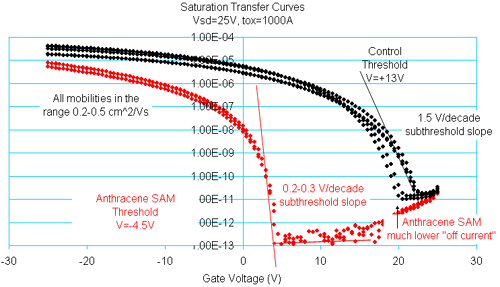

Research in our group is in the general area of interface chemistry. In particular, we study the bonding of organics to solid surfaces. Composite inorganic-organic or even organic-organic systems are important components of various types of "high tech" devices, and we are interested in two such areas. The first involves surface modification of inorganic conductor or semiconductor surfaces as a means to enhance performance of devices as diverse as diodes, organic transistors, or biosensors. The second aims to develop strong interfaces between implant or tissue scaffold surfaces and biomolecules in the context of enhancing tissue integration with a prosthetic device. At first glance, these areas (electronic devices and surgical implants) might seem rather unrelated. But, in fact, at the level of interfacial chemistry, they involve conceptually quite similar issues! Check out our three small presentations (Synthesis and Characterization, Biomaterials, and Electronic Materials) that illustrate our current work.
Two general methods of approach comprise our study of interfaces. The first involves deposition of discrete organometallic complexes onto solid surfaces. We have been aided in this effort through our long-standing collaboration with Prof. Steven Bernasek, who is an expert in ultra-high vacuum surface science. Together, we create novel protocols for surface modification using these organometallic complexes, and we characterize each stage of our modification procedures using the techniques of modern surface science. In this context, we have shown that we can correlate device properties with structural features of organics deposited onto electrode surfaces. Below we illustrate the effect of binding a well-defined complex of tin to the surface of ITO in the context of organic light emitting diode behavior. Note the greatly enhanced current density (by about 4000-fold) and luminance for the surface modified device (A) compared with the untreated control (B).
Our second area of interest exploits a fundamentally new method we have devised that enables us to grow self-assembled monolayer films of phosphonates (SAMPs) on a large variety of oxide-coated surfaces of simple or even complex shapes. We have nicknamed this preparative method the "T-BAG", and it enables SAMP growth and bonding to bulk oxides such as ITO or to the native oxide surfaces of Si, Ti, and several Ti alloys which are currently in use as implant materials. Here, our newly acquired high resolution X-ray photoelectron spectrometer has proven to be especially valuable to determine homogeneity of our surface-bound SAMPs. In the figure below, the differential effect of an applied bias to a surface coated with both a bound SAMP and unbound, multilayer phosphonic acid is illustrated in an XPS experiment examining binding energies for C(1s). The carbons of the bound SAMP do not shift with the applied bias, but those of the multilayer do.
One goal for film growth is to devise new methods to bond organic semiconductors, such as a SAMP of anthracene phosphonate shown below, to the surfaces of conductors or semiconductors in the context of making new types of microelectronic devices. In the figure below, we show thin film transistor behavior for a device based on pentacene. Here, we collaborate with Prof. Antoine Kahn in the Department of Electrical Engineering at Princeton, Dr. Norbert Koch in Germany and Prof. Ian Hill in Canada studying how interfacial structure may affect performance of these electronic devices.

Another goal for surface modification is to enhance interactions between inorganic surfaces and living tissue as a means to stabilize surgically implanted devices or tissue scaffolds. We actively collaborate with Prof. Jean Schwarzbauer
in the Department of Molecular Biology studying how surface modification affects cell interactions with our materials, and we have shown that true osseointegration can be accomplished using our SAMP methods. The figure below illustrates bone growth in vivo into the channeled structure of a Ti implant; the exposed surfaces of the implant are treated with a peptide-terminated SAMP that encourages osteoblast growth within the channels.
A developing area of interest for us is the surface activation of organic polymers to enhance their efficacy as tissue scaffolds. Our new procedures enable the bonding of cell signaling peptides on synthetic or biopolymer surfaces at levels at least an order of magnitude greater than accomplished by any other means. The figures below show the effect of our surface treatment on cell spreading (C) on nylon (A) vs. an untreated control (B).